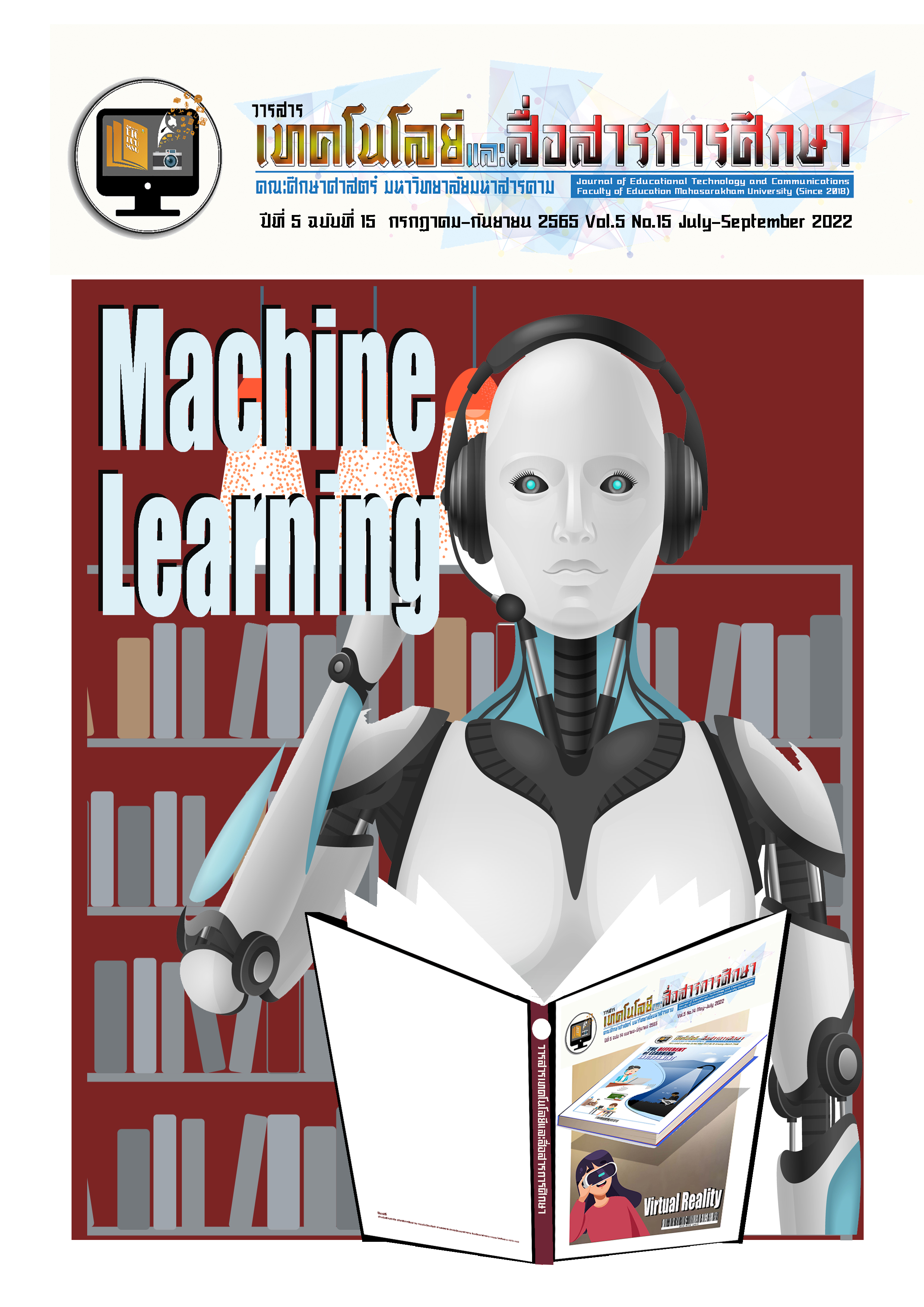การจัดกิจกรรมการเรียนรู้แบบผสมผสาน โดยใช้เทคนิคการเรียนแบบสืบสอบ หาความรู้เป็นกลุ่ม (Group Investigation: GI) เพื่อส่งเสริมทักษะการคิดเชิงคำนวณ สำหรับนักเรียนชั้นมัธยมศึกษาปีที่ 1
Main Article Content
บทคัดย่อ
การวิจัยครั้งนี้มีวัตถุประสงค์ 1) เพื่อพัฒนาห้องเรียนจัดกิจกรรมการเรียนรู้แบบผสมผสาน โดยใช้เทคนิค การเรียนแบบสืบสอบหาความรู้เป็นกลุ่ม สำหรับนักเรียนชั้นมัธยมศึกษาปีที่ 1 ให้มีประสิทธิภาพตามเกณฑ์ E1/E2 เท่ากับ 80/80 2) เพื่อเปรียบเทียบทักษะการคิดเชิงคำนวณ ด้วยห้องเรียนจัดกิจกรรมการเรียนรู้แบบผสมผสาน โดยใช้เทคนิคการเรียนแบบสืบสอบหาความรู้เป็นกลุ่ม ระหว่างก่อนและหลังเรียน 3) เพื่อเปรียบเทียบผลสัมฤทธิ์ทางการเรียนหลังเรียน ของนักเรียนชั้นมัธยมศึกษาปีที่ 1 ระหว่างห้องเรียนจัดกิจกรรมการเรียนรู้แบบผสมผสาน โดยใช้เทคนิคการเรียน แบบสืบสอบหาความรู้เป็นกลุ่ม กับห้องเรียนการสอนแบบปกติ 4) เพื่อเปรียบเทียบทักษะการคิดเชิงคำนวณหลังเรียน ของนักเรียนชั้นมัธยมศึกษาปีที่ 1 ระหว่างห้องเรียนจัดกิจกรรมการเรียนรู้แบบผสมผสาน โดยใช้เทคนิคการเรียน แบบสืบสอบหาความรู้เป็นกลุ่ม กับห้องเรียนการสอนแบบปกติ 5) เพื่อศึกษาความพึงพอใจของนักเรียนที่มี ต่อการจัดกิจกรรมการเรียนรู้แบบผสมผสาน โดยใช้เทคนิคการเรียนแบบสืบสอบหาความรู้เป็นกลุ่ม กลุ่มตัวอย่างที่ใช้ ในการศึกษาครั้งนี้เป็นนักเรียนชั้นมัธยมศึกษาปีที่ 1 ที่กำลังศึกษาในโรงเรียนขยายโอกาสเครือข่ายสถานศึกษาที่ 2 จำนวน 50 คน ได้มาโดยการสุ่มแบบแบ่งกลุ่ม (Cluster Random Sampling) ใช้ห้องเรียนเป็นหน่วยของการสุ่ม ซึ่งมีเครื่องมือที่ใช้ในการวิจัย ได้แก่ 1) แผนการจัดกิจกรรมการเรียนรู้แบบผสมผสาน โดยใช้เทคนิคการเรียนแบบสืบสอบหาความรู้เป็นกลุ่ม 2) แบบวัดทักษะการคิดเชิงคำนวณ จำนวน 12 ข้อ 3) แบบทดสอบวัดผลสัมฤทธิ์ทางการเรียนรายวิชาวิทยาการคำนวณ จำนวน 30 ข้อ 4) แบบสอบถามความพึงพอใจ
ผลการวิจัยพบว่า
1) การจัดกิจกรรมการเรียนรู้แบบผสมผสาน โดยใช้เทคนิคการเรียนแบบสืบสอบหาความรู้เป็นกลุ่ม เพื่อส่งเสริมทักษะการคิดเชิงคำนวณที่มีประสิทธิภาพ (E1/E2) เท่ากับ 80.53/87.20 ซึ่งเป็นไปตามเกณฑ์ที่กำหนดไว้
2) ทักษะการคิดเชิงคำนวณหลังเรียน โดยใช้เทคนิคการเรียนแบบสืบสอบหาความรู้เป็นกลุ่มและการเรียนการสอนแบบปกติ มีความแตกต่างกันอย่างมีนัยสำคัญทางสถิติที่ระดับ .05
3) การเปรียบเทียบผลสัมฤทธิ์ทางการเรียนก่อนเรียนและหลังเรียน ห้องจัดกิจกรรมการเรียนรู้ แบบผสมผสาน โดยใช้เทคนิคการเรียนแบบสืบสอบหาความรู้เป็นกลุ่ม และการเรียนการสอนแบบปกติ มีคะแนนผลสัมฤทธิ์ทางการเรียนเฉลี่ยหลังเรียนสูงกว่าก่อนเรียนด้วยวิธีปกติอย่างมีนัยสำคัญทางสถิติที่ระดับ .05
4) ผลสัมฤทธิ์ทางการเรียนหลังเรียน ห้องจัดกิจกรรมการเรียนรู้แบบผสมผสาน โดยใช้เทคนิคการเรียนแบบสืบสอบหาความรู้เป็นกลุ่ม และการเรียนการสอนแบบปกติ มีความแตกต่างกันอย่างมีนัยสำคัญทางสถิติที่ระดับ .05
5) นักเรียนชั้นมัธยมศึกษาปีที่ 1 ที่มีต่อการจัดกิจกรรมการเรียนรู้แบบผสมผสาน โดยใช้เทคนิคการเรียนแบบสืบสอบหาความรู้เป็นกลุ่ม มีความพึงพอใจในระดับมากที่สุด (= 4.75, S.D. 3.13)
Downloads
Article Details
References
กระทรวงศึกษาธิการ. (2560). หลักสูตรแกนกลางการศึกษาขั้นพื้นฐาน พุทธศักราช 2551 (ฉบับปรับปรุง พุทธศักราช 2560). https://drive.google.com/file/d/1mKyU6tkVWlL5b6vfwHNEzqkcqVXf_H-m/view
จุฑารัตน์ ทับอุดม. (2559). ผลการใช้กิจกรรมการเรียนรู้วิทยาศาสตร์โดยใช้รูปแบบสืบสอบหาความรู้เป็นกลุ่มที่มีต่อความสามารถทางสังคมของนักเรียนชั้นประถมศึกษา. [วิทยานิพนธ์ปริญญามหาบัณฑิต จุฬาลงกรณ์มหาวิทยาลัย]. https://uctal.thailis.or.th /Catalog /BibItem.aspx?BibID=b02994233
ชัยยงค์ พรหมวงศ์. (2545). เอกสารประกอบการสอนชุดวิชาเทคโนโลยีการศึกษา หน่วยที่ 1-5. ุ สำนักเทคโนโลยีทางการศึกษามหาวิทยาลัยสุโขทัยธรรมาธิราช.
เนตรนภา เอี่ยมอนุพงษ์, ดิเรก ธีระภูธร, พิชัย ทองดีเลิศ และทำรงลักษณ์ เอื้อนครินทร์. (2559). การพัฒนารูปแบบการเรียนการสอนแบบผสมผสาน เรื่องความรู้เกี่ยวกับอาเซียน สำหรับนักเรียนระดับประถมศึกษาที่มีรูปแบบการเรียนต่างกัน. วารสารวิชาการมหาวิทยาลัยอุตรดิตถ์. 11(1), https://ph01.tci-thaijo.org/index.php/uruj/article/view/63410
บุญชม ศรีสะอาด. (2546). การพัฒนาหลักสูตรและการวิจัยเกี่ยวกับหลักสูตร. ุสุวีริยาสาสน.
บุญชม ศรีสะอาด. (2553). การวิจัยเบื้องต้น. (พิมพ์ครั้งที่ 8). สุวีริยาสาส์น.
พิชญานิน ศิริหล้า. (2561). ผลการจัดการเรียนรู้ตามแนวฉันทศึกษา เพื่อส่งเสริมการคิดเชิงคำนวณ (Computational thinking) และการทำงานเป็นทีม ในวิชาฉันทศึกษา สำหรับนักเรียนชั้นประถมศึกษาปีที่3 โรงเรียนสาธิตมหาวิทยาลัยศรีนครินทรวิโรฒประสานมิตร (ฝ่ายประถม). [วิทยานิพนธ์ปริญญามหาบัณฑิต, มหาวิทยาลัยศรีนครินทรวิโรฒ]. http://ir-ithesis.swu.ac.th/dspace/ bitstream /123456789/310/1/gs571130081.pdf
ภัททิญา ศักดิ์พิพัฒน์ดำรง และ เหมมิญช์ ธนปัทม์มีมณี. (2560). การพัฒนาบทเรียนบนเว็บตามทฤษฏีคอนสตรัคติวิสต์ที่มีต่อผลสัมฤทธิ์ทางการเรียนและการคิดแก้ปัญหาของนักเรียนชั้นมัธยมศึกษาปีที่ 3. วารสารศึกษาศาสตร์ มหาวิทยาลัยมหาสารคาม, 12(2) http://edu.msu.ac.th/journal/home/journal_file/463.pdf
โรงเรียนบ้านโพธิ์ศรี. (2562). Self Assessment Report โรงเรียนบ้านโพธิ์ศรี ประจำปีการศึกษา 2562. โรงเรียนบ้านโพธิ์ศรี.
ศุภวัฒน์ ทรัพย์เกิด. (2559). การจัดกิจกรรมการเรียนรู้ เพื่อเสริมสร้างการคิดเชิง ประมวลผลด้วยการจัดการเรียนรู้แบบสะเต็มศึกษา วิชาโปรแกรมและการ ประยุกต์ ชั้นมัธยมศึกษาปีที่ 4 โรงเรียนอนุกูลนารี. [วิทยานิพนธ์ปริญญามหาบัณฑิต มหาวิทยาลัยราชภัฏมหาสารคาม].http://fulltext.rmu.ac.th/fulltext/2559/121281/Supawat%20Sabkerd.pdf
สถาบันส่งเสริมการสอนวิทยาศาสตร์และเทคโนโลยี. (2560). คู่มือการใช้หลักสูตรรายวิชาพื้นฐาน วิทยาศาสตร์ กลุ่มสาระการเรียนรู้วิทยาศาสตร์ (ฉบับปรังปรุง พ.ศ. 2560) ตามหลักสูตร แกนกลางการศึกษาขั้นพื้นฐาน พุทธศักราช 2551 สาระเทคโนโลยี (วิทยาการคำนวณ) ระดับประถมศึกษาและมัธยมศึกษา. สถาบันส่งเสริมการสอนวิทยาศาสตร์และเทคโนโลยี.
สมนึก ภัททิยธนี. (2546). การวัดผลการศึกษา. (พิมพ์ครั้งที่ 4). ประสานการพิมพ์.
สายชล แก้วเพชร และ กันยารัตน์ สอนสุภาพ. (2561). การพัฒนาการจัดการเรียนรู้วิทยาศาสตร์ โดยใช้ผังกราฟิกประกอบการสอนแบบ GI เพื่อส่งเสริมผลสัมฤทธิ์ทางการเรียน และความสามารถด้านการคิดวิเคราะห์ของนักเรียนชั้นประถมศึกษาปีที่ 3. วารสารการวัดผลการศึกษา มหาวิทยาลัยมหาสารคาม 25(1) https://www.tci-thaijo.org/index.php/jemmsu/article/download/199147/138885/
Barefoot, C.A.S. (2014). Computational thinking. https://barefootcas.org.uk/wpcontent/uploads/2014/10 /Computational-thinkingBarefoot-Computing.
Gonzalez, M.R., Gonzalez, J.P. and Fernandez, C.J. (2016). Which cognitive abilities underlie computational thinking? criterion validity of the computational thinking test. Computers in human behavior, 72, https://www.sciencedirect. com/science/article/abs/pii/S0747563216306185
Wing, J.M. (2006). Computational thinking. Communication of the ACM, 49(3), https://dl.acm.org/ doi/10.1145/ 1118178.1118215

